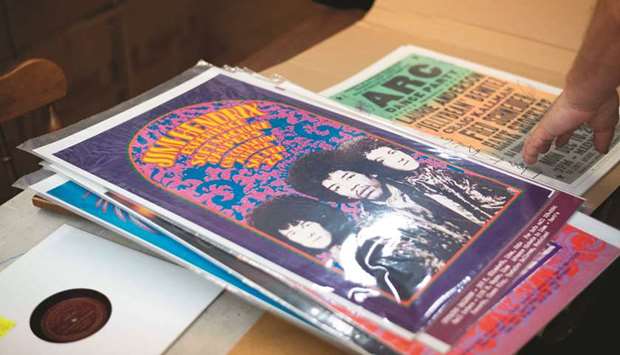The turntable needle drops and the sounds of an obscure band The Motifs ring out, bouncing off mountains of records lining the musty warehouse housing America’s largest pop music collection.
The cavernous independent private music library, known as the ARChive of Contemporary Music, on a non-descript street in lower Manhattan’s Tribeca neighbourhood claims more than three million recordings — mostly vinyl and some CDS and cassettes, not to mention a vast collection of memorabilia.
“You’re just constantly discovering things that you wouldn’t know,” its co-founder B George told AFP from his desk tucked behind the stacks.
In an age dominated by streaming and the ephemerality of digital media, places like the ARChive can prove vital to preserving physical copies of music that can be key to future listening.
News over the summer that some 500,000 recordings from legends like Billie Holiday, Louis Armstrong, Joni Mitchell and Eric Clapton were destroyed in a 2008 blaze at Universal Studios threw the importance of safeguarding physical copies into stark relief.
Some of the work lost included master recordings, the raw material for lucrative reissues and posthumous releases.
While nothing can replace a lost master, George said labels have called on his archive to hear versions as close to the original as possible.
Two discs of a reissue from the late Nigerian superstar Fela Kuti, for example, were made from vinyl belonging to the ARChive.
“Trying to keep a collection intact is really important,” George said.
George started the archive in 1985, when the area was just beginning to attract artists eager to colonise the old warehouses for cheap.
At one point the archive scored 125,000 classic rock LPs (long play records) — some 1,500 of them signed by artists including Jimi Hendrix — from a house in Boston that was condemned after it was found to be literally sinking under the weight of the vinyl.
Contrary to the snobbish reputation often ascribed to collectors and curators, the ARChive welcomes essentially everything related to pop music — which it defines as “not classical” — with open arms.
And it relies on philanthropy to pay the ever-increasing rent in one of the country’s most expensive zip codes, especially from celebrity musicians.
Early supporters included avant garde performer Laurie Anderson — who George introduced to her future husband, Lou Reed — and Nile Rodgers, known for hits like Le Freak by his disco group Chic, the original sheet music of which lives at the ARChive.
Current board members include Rodgers, Richards, Youssou N’Dour, Martin Scorsese and Paul Simon, while both Reed and David Bowie are emeritus.
Today the mammoth collection — maintained by George and a revolving door of volunteers and interns — is used primarily for research by the recording industry as well as filmmakers and researchers.
The Grammy Museum, for example, once needed 3,000 record labels and covers for graphics, and turned to George.
“You can come to us and say I need 3,000 things in two weeks and there’s a good chance we’re going to have almost all of them,” he said.
But though George sees the preservation of the physical as a vital task, he says “everything is fugitive” to the prospect of disaster.
The ARChive is working with the San Francisco-based nonprofit Internet Archive to start digitizing, and keep “as many things in as many places as possible.”
Some 130,000 78rpm records — brittle vinyls usually made of shellac resin, popular until the mid-20th century — have been digitised so far, for example, and are available for free streaming online, George said.
“Libraries burn,” he said. “Realistically in 5,000 years this will all be dust.”
“You do your best, you hope that the migration will happen, that it’ll go to the next stage, it’ll go to the next way of being preserved, but it’s unpredictable.”
International / US/Latin America
ARChive strives to keep vinyl musical heritage alive in digital age

A poster of the Jimi Hendrix Experience being displayed at the ARChive in New York.


